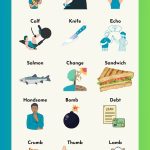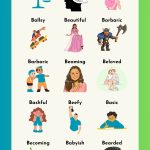If you’re looking for some of the best phonics games for kindergarten or 1st graders, then you’re definitely in the right place. We have more than 20 phonics activities, along with recommendations for online practice, worksheets, and more. Have some fun developing reading skills using phonics!

Phonics games kindergarten and first grade
Phonics Games for Kids
Let’s get into the best phonics activities and games for children.
#1: Missing Letters Phonics Game
Before class, hide a bunch of sticky notes with letters on them around the classroom. Write down a bunch of words on the whiteboard that have some of the letters missing. Students have to hunt for the letters and once they find one, come up to the board to see if it fits somewhere.
#2: Walk the Words
Go outside and have some fun with reading and phonics. Write a bunch of simple words in chalk on the sidewalk. Students can walk the word, sounding them out as they go along. At the end of the word, they can say what it is.
#3: The Disappearing Sentence
Try out this simple game once students have mastered some basic words. Write down a sentence on the board. For example:
- A cat and a dog.
Have students say it out loud. Then, erase one of the words and students have to say the sentence. Continue until nothing is left. Check it out:
Disappearing sentence activity.
#4: Dictation Writing Activity
A nice way to see, in black and white who knows the letter sounds and who doesn’t is to do a simple dictation activity. For beginners, say the word (cat) and students have to write it down in their notebooks. For absolute beginners, give some hints and slowly sound out the word.
#5: Use Total Physical Response for Phonics
Kids love to get out of their seats and move around the classroom. Using total physical response (TPR) is a nice way to do that. There are a few options depending on the level of students:
- Place flashcards or pieces of paper with letters around the classroom. Say the letter and have students move to touch it.
- Say the sound of the letter and students have to touch it.
- You can say the sound or letter and have students touch something that starts with that letter.
#6: Puzzle Finder Phonics Game
Use actual puzzle pieces or print out some bigger ones and laminate them. On each piece, write either the first or second half of simple words that students are learning (dog, top, cat, fish).
Give each student a puzzle piece and they have to find their match. Once they do, the students have to figure out how to say the word. They can do so in front of the whole class once everyone has found their matches.
#7: Odd One Out
Once students are a bit more proficient with phonics, consider using odd one out. Write sets of 4 words, 3 of which fit together and one that doesn’t. For example:
- met
- wet
- set
- seat
Seat is the odd one out because it has a long “e” sound, not a short one.
#8: Phonics Memory Circle
The memory circle is a versatile activity that can be used for a lot of things and it also works well for phonics.
Have all the students stand up. The first student says a letter and the associated sound (d-duh). The second student repeats that and adds their own (d-duh, s-sss). Continue on. If someone misses or gets it wrong, they sit down and are out. Play until only a few people are left standing.
#9: Sing a Phonics Song
Not musical, not to worry! Neither am I. Have a look on YouTube and you’ll find a ton of great options for phonics songs to choose from.
#10: Drill Sounds and Letters when Teaching Phonics
A nice way to teach phonics is to use some drilling exercises. One that I use for young learners is to say the letter, sound, and a word that starts with it. For example:
- A, aaaa, apple.
- B, buh, bat.
I have students repeat after me and clap along. This helps students remember the letter sounds which is obviously key to learning how to read!
#11: Match the Spoons
Use plastic spoons and write down beginnings and ends or words on the end portion. Students have to find two that work together. Once everyone has two spoons they think will make a word, stop, and each student can hold them up and say their word.
#12: Flyswatter
It’s possible to use this interactive game for phonics. Write the letters on the board in a random fashion. Then, say a letter sound and students race to slap the letter. Or, say a word and students have to slap the first letter of that word.
#13: Picture Prompt Phonics
This is a simple warmer activity. Show students a picture with some familiar words in it. They can shout out words that they might know (cat). The teacher can sound out the letters in that word and elicit the letters from the students in order to spell the words correctly.
#14: Magazine Hunt
Try out this fun activity once students are a little bit proficient with reading. Give each student or group a magazine and say a letter. Students have to hunt for pictures of things that begin with that letter. Once they find something, they can shout it out.
#15: Phonics Scavenger Hunt
This is an interactive classroom activity. Assign a letter to each student or small group. Then, they have to move around the classroom and find 3 objects that begin with that letter. If it’s feasible, they can bring them to their desk. If not, they can make a mental note of it. When everyone is done, they can say the letter and objects that they found.
#16: Phonics Whiteboard Race
This is a simple activity for teaching phonics. There are a few options, depending on the level of students:
- Say the sound and students have to write the letter.
- Say the sound and students have to write both the lowercase and the uppercase forms.
- Students have to write the first letter of the word that the teacher says.
- Say a simple word and students have to spell it correctly.
#17: Chain Spelling
This is a nice activity that works on the spelling of basic words. Say a simple word and students can use phonics to sound it out and spell it. Find out more about it here: Chain Spelling Game.
#18: Mix and Match Cups
In permanent marker, write down letters or letter combinations on plastic party cups. Students have to use 2 or more cups to make a word.
#19: Focus on Pronunciation
Phonics and pronunciation go hand in hand. Why learn how to read if you don’t say the words correctly? I like to nip bad pronunciation in the bud and start early! Here are some of my go-to activities for this:
#20: Ideas for Teaching New Words
#21: Pass the Phonics Ball
Get a ball or beach ball. The person holding it says a letter and tosses the ball to someone else who has to say a word that starts with it. That person says a letter and tosses the ball to someone else.
#22: Mystery Phonics Bag
Put a few objects in a bag that begin with the same letter (pen, pencil, potato). Have students feel what’s inside the bag (but not look) in order to identify the secret letter.
#23: Phonics I Spy
This is a classic phonics game! Start it off with the phrase, “I spy something that starts with ____ (letter). Students have to look around and guess things that they can see that start with the letter.
#24: Snowman Phonics
Draw a picture of a snowman with a nose, eyes, hat, arms, scarf, etc. Say a letter and students have to erase something that starts with that letter. You can also draw whatever other kind of picture you’d like and repeat the game.
#25: What’s My Phone Number?
Use minimal pairs (words that differ by only one sound) and/or similar words and assign a letter to each one. For example:
- pet (0), pit (1), peat (2), pot (3), top (4), tom (5), tap (6), etc.
Then say the words and students have to write down the associated phone number.
Teaching Phonics FAQs
There are a number of common questions that people have about teaching phonics. Here are the answers to some of the most popular ones.
What are the steps to teaching phonics?
Here are some of the most important steps for teaching phonics:
- Teach letter sounds.
- How to blend sounds.
- Complex words.
- Vowel combinations.
- Exceptions.
- Accuracy and fluency.
What are the 5 principles of phonics?
The 5 principles of phonics are:
- Linking phonemic awareness to letter sounds.
- Teach phonics systemically and explicitly.
- Allow time for practice with reading and writing.
- Be flexible (focus on students’ needs).
- Use an integrated literacy program.
What is the best approach to teaching phonics?
The best approach to teaching phonics is one that is systemic and comprehensive. This can help at-risk students and those with reading difficulties.

Phonics activities
Online Practice for Phonics
Parents often want recommendations for phonics practice that their children can do online. Here are some of the top resources:
Phonics Worksheets
Save time with these free phonics worksheets for kids:
More Ideas for Teaching Reading
- Bolen, Jackie (Author)
- English (Publication Language)
- 84 Pages - 06/01/2020 (Publication Date) - Jackie Bolen (Publisher)
Start with phonics but once children know how to read, there are plenty of other activities to work on this important skill. Check out some of my top picks right here: ESL Reading Activities for Kids.
Pick up a copy of the book today and get ready for better classes tomorrow!
Phonics Games: Join the Conversation
Do you have any fun phonics activities for children that you’d like to add to the list? Please leave a comment and let me know. We’d love to hear from you.
Last update on 2024-04-14 / Affiliate links / Images from Amazon Product Advertising API







Leave a Reply